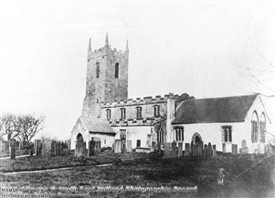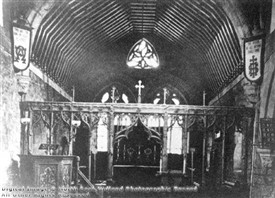St Giles West Bridgford Restored

Above is a photograph from the south-east taken before the 1871-72 refurbishment, probably about 1860. The photograph seems to show the church still in open country. The church was rebuilt by 1898.
Image from Picture the Past, www.picturethepast.org.uk (reproduced with permission)

Above is an image of the interior of St Giles in around 1895, before it was rebuilt in 1898.
Image from Picture the Past, www.picturethepast.org.uk (reproduced with permission)
The Opinions and Laments of a Local Observer Writing at the End of the 19th Century
By Betty Rose
Over the centuries St Giles has known a number of alterations and adaptations.
In the course of the 1871-72 refurbishment and under the supervision of no lesser architect than T.C. Hine, one local historian took an active interest in surveying the work and did not hold back his criticism when this seemed to be called for. In the September and November 1895 editions of Notts & Derbyshire Notes and Queries W. P. W. Phillimore submitted two articles from which we reproduce extensive sections below.
The Restoration of West Bridgford Church
by W. P. W. Phillimore, M.A., B.C.L.
In 1871 West Bridgeford was still a pretty country village, and the railway had not done away with the footpath through the fields leading to the church, which hitherto had not undergone the ordeal of "restoration." Living then at Snenton, I frequently took a walk across the Trent Bridge to West Bridgeford church. The restoration of the church took place in the latter part of that year, and I made constant visits to it during the progress of the work, and took careful notes about it on each occasion I was there. It may be of interest to those who have only known St. Giles' Church in its present restored condition to have some account of its former state, and the restoration which was carried out under the direction of a local architect.
The church was, no doubt, in want of considerable repair, and the interior was disfigured by high deal pews of irregular shape, whilst a singing gallery, erected about seventy or eighty years ago, blocked up the tower arch. The chancel was filled with square pews, put up some time in the twenties or early thirties, at a time when the use of a chancel was pretty well forgotten, or was viewed as an anachronism, or, at best, a survival from "Roman" days. The chancel appears to have been new-roofed then, and was generally "beautified," a process which was as destructive in the days of our grandfathers as "restorations" are now. A flat ceiling had been put in, blocking up part of the two beautiful east windows of the chancel, as well as the curious triangle window above them. The easternmost lancet window on the north side of the chancel was then walled up, and the exterior stuccoed to represent masonry. Benches — taken, it is said, from St. Mary's, Nottingham — formerly existed in the chancel, but these were replaced by the pews already mentioned. Over the chancel screen had been a singing loft, but this was done away with, as well as the staircase on the south side which led up to it. The architect during the restoration pulled down some portion of the north wall in an unsuccessful attempt to discover the stairs to this rood loft. Whitewash covered the whole of the interior, but, depressing in appearance as whitewashed walls are, many will agree in the opinion that bare rubble walls, roughly pointed, are not a bit better in appearance.
There were several fragments of stained glass of considerable merit still left in the windows. A fine medallion in a window on the north side of the nave was broken shortly before the restoration. Other glass was destroyed in the course of that process; amongst it was the coat of arms of the ancient lords of the manor — the Luterels, who died out in the male line as long ago as the year 1418. That so interesting a relic — their sole memento in the place — should have been thus destroyed, is a fact which reflects great discredit upon the architect, rector, and others responsible for the restoration. In the same window was also the shield of the Alfreton family, and this shared the fate of the Luterel coat. […]
The first steps were taken on the 11th of August, 1871 , when the workmen, without any adequate supervision, commenced to remove the fittings and to strip the plaster from the walls. My first visit was made on 21st August. By that time, a little window in the gable of the porch, which had been plastered up, was exposed to view, and the lancet window in the chancel before mentioned had been opened out. In connection with the latter, a most interesting discovery was made. The window jambs and arch were painted in a sort of distemper to represent sienna and white marble in a somewhat conventional manner. On the western side was a large shield of early form outlined with a broad black line. It was in height 2ft. 8in., and 1ft. 9in. wide, and bore argent, five fusils gules, each charged with an escallop of the field. The fusils, which were 17in. long, were painted in vermillion, and the escallops were outlined in black. These appear to have been the arms of the ancient Nottinghamshire family of Aslacton, of Aslacton, though no mention of this family is to be found in the pages of Thoroton in connection with West Bridgeford .* The day after these par ticulars had been noted, this interesting painting was scraped off by the workman.
All the pews in the church were taken out, and numerous frag ments of the ancient oak bench ends and poppyheads — many of them handsomely carved in various designs — were found worked up in the modern pews. What became of them? They might have been utilised as patterns for new seats, which would have had a far more handsome appearance than the present varnished pine benches. But restorers like to have a clean sweep and to have everything quite new, spick and span, all complete for the opening ceremony. Money is never too plentiful, and the natural result is that much of the new work thus hastily put in is of a cheap and flimsy character. Far better would it be if they could be induced to follow an old motto, "festina lente," and carry out church restoration by degrees. An opportunity was lost at West Bridgeford . Of several of these bench ends the writer made sketches before they disappeared. […]
(To be continued)
Published in Notts & Derbyshire Notes and Queries, September 1895, pp. 129-131
The Restoration of West Bridgeford Churcb
by W. P. W. Phillimore, M.A., B.C.L.
II.
[…] In this south aisle, a little west of the entrance, was found a small doorway, perhaps leading to a parvise over the porch; it was nearly square-headed, about 5ft. 2in. high by 1ft. 10in. wide. There was a heavy mediaeval oak door to the porch, evidently having been removed from the inner doorway, which the workmen were allowed to burn for firewood, though it might well have been repaired. What became of its ponderous key, some fifteen inches long? […]
On the nave wall, between the two north windows, had been painted the Commandments, and below them were traces in red of some earlier mural decoration. The chancel screen was temporarily removed. One feature should be noted about the double east window: part of the sill of the more northerly one was formerly a foot lower. Coloured decoration remained on the arch on the north side; the crest was painted a sea green, and the mouldings green and vermilion. It is clear there must have been some brilliant colouring in the mediaeval Bridgeford church; too striking, no doubt, for the sober taste of an age which delights in sage-greens and old gold. Traces of colour, a dull red, were found on the jambs of the east window of the aisle, as well as on the south wall of the chancel; in fact, the whole of the chancel was painted in colour, even the exterior. […]
It may be worth while noting that in the demolition of the chancel wall old arched stones of some earlier building were found. By November one of the doves in the stained glass of the east window of the aisle had disappeared, as also the stained glass, a crown, in the second south window. The two alabaster sepulchral slabs in the chancel were cut up to form the communion step; one of the slabs, that which lay next to the chancel door, was found to be inverted, thus indicating some earlier disturbance of the floor.
*Since writing the earlier portion of this article, I have had an opportunity of consulting Mr. Godfrey's excellent monograph on the churches of Rushcliffe Hundred, and the list of rectors therein contained shows that John de Aslac ton, junior, was instituted 28th July, 1349, on the presentation of Sir Andrew Luterel, and was succeeded on his death, some twenty years later, by Thomas de Owthorpe. In this fact we have a clear confirmation of the identifica tion of the arms painted on the jamb of the chancel window with those of the Aslacton family. They were doubtless put during the twenty years (1349- 1369) of this rector's incumbency, and may, perhaps, indicate the date when the north wall of the chancel was rebuilt. It is an apt illustration of the way in which interesting antiquities are frequently destroyed through the inadequate supervision given by those responsible for church restorations. […]”
Published in Notts & Derbyshire Notes and Queries, November 1895, pp.161-163